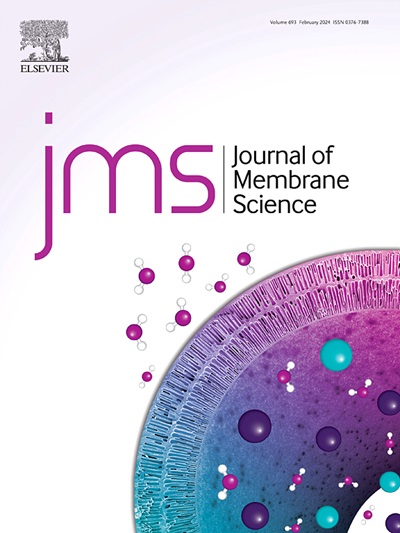Ion-selective vermiculite nanochannel membrane with water anchoring effect for efficient energy recovery from water evaporation
IF 8.4
1区 工程技术
Q1 ENGINEERING, CHEMICAL
引用次数: 0
Abstract
Evaporation, a fundamental process in water treatment, is often criticized for its high energy damans. Harnessing the natural movement of water through confined capillary channels during evaporation offers a promising approach for energy extraction. Despite this potential, existing systems face significant challenges, including limited energy conversion efficiency, high costs and complex fabrication, which restrict their practical application. In this study, we present a cost-effective two-dimensional (2D) vermiculite nanochannel membrane, fabricated via an environmentally process, for efficient energy harvesting from evaporation. When partially immersed into the water, the vermiculite membrane achieved a stable voltage output of 1 V over two weeks at room temperature. The superhydrophilic vermiculite nanochannels facilitated smooth water molecule entry, while the hydration layer remained firmly anchored, even under varying aqueous conditions. Furthermore, overlapping electric double layers (EDLs) formed within the highly negatively charged nanochannels, enabling excellent proton selectivity. Protons, generated by water dissociation and deprotonation of oxygen-containing functional groups, were efficiently transported through the nanochannels, leading to ion polarization at the electrodes and the generation of a continuous streaming potential. By optimizing the membrane geometry, solution conditions, and evaporation environment, energy conversion efficiency was significantly enhanced. Moreover, connecting three membrane-based devices in series allowed for the successful charging of three parallel-connected 47 μF commercial capacitors to 2.4 V, providing enough power to illuminate an LED. This study underscores the considerable potential of evaporation-driven energy harvesting and lays the foundation for scalable, self-sustaining evaporation systems.

具有水锚定效应的离子选择蛭石纳米通道膜,用于水蒸发的高效能量回收
蒸发是水处理的一个基本过程,常因其高能量消耗而受到批评。在蒸发过程中利用水通过受限毛细管通道的自然运动为能源提取提供了一种很有前途的方法。尽管有这种潜力,但现有的系统面临着巨大的挑战,包括有限的能量转换效率、高成本和复杂的制造,这些都限制了它们的实际应用。在这项研究中,我们提出了一种具有成本效益的二维(2D)蛭石纳米通道膜,通过环保工艺制造,用于有效地从蒸发中收集能量。当部分浸入水中时,蛭石膜在室温下两周内实现了1 V的稳定电压输出。超亲水性蛭石纳米通道促进了水分子的平稳进入,而水合层即使在不同的水条件下也能保持牢固的锚定。此外,在高负电荷的纳米通道内形成重叠的双电层(edl),实现了优异的质子选择性。由水解离和含氧官能团的去质子化产生的质子通过纳米通道有效地传输,导致电极处的离子极化并产生连续的流电位。通过优化膜的几何形状、溶液条件和蒸发环境,可以显著提高能量转换效率。此外,将三个膜基器件串联起来,可以成功地将三个并联的47 μF商用电容器充电到2.4 V,从而提供足够的功率来照亮LED。这项研究强调了蒸发驱动的能量收集的巨大潜力,并为可扩展的、自我维持的蒸发系统奠定了基础。
本文章由计算机程序翻译,如有差异,请以英文原文为准。
求助全文
约1分钟内获得全文
求助全文
来源期刊

Journal of Membrane Science
工程技术-高分子科学
CiteScore
17.10
自引率
17.90%
发文量
1031
审稿时长
2.5 months
期刊介绍:
The Journal of Membrane Science is a publication that focuses on membrane systems and is aimed at academic and industrial chemists, chemical engineers, materials scientists, and membranologists. It publishes original research and reviews on various aspects of membrane transport, membrane formation/structure, fouling, module/process design, and processes/applications. The journal primarily focuses on the structure, function, and performance of non-biological membranes but also includes papers that relate to biological membranes. The Journal of Membrane Science publishes Full Text Papers, State-of-the-Art Reviews, Letters to the Editor, and Perspectives.
 求助内容:
求助内容: 应助结果提醒方式:
应助结果提醒方式:


